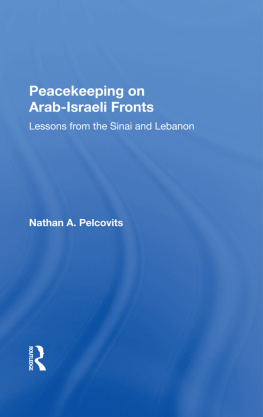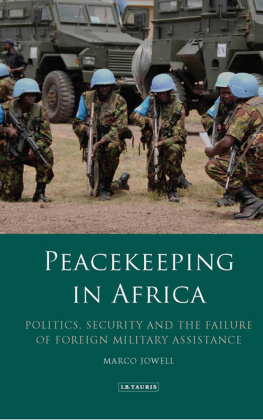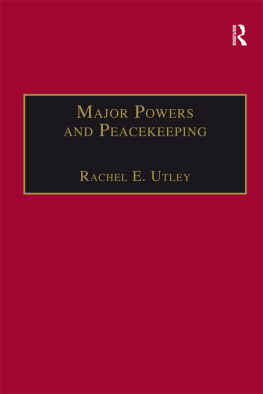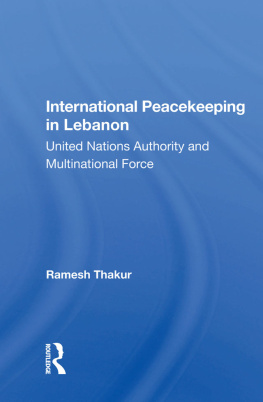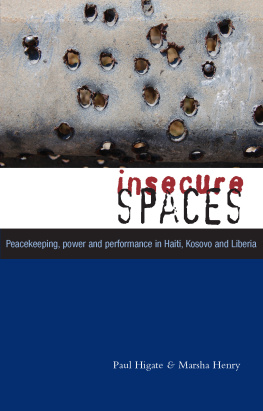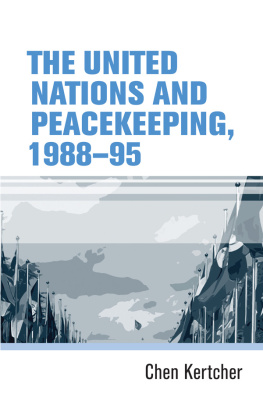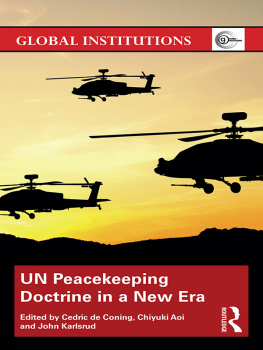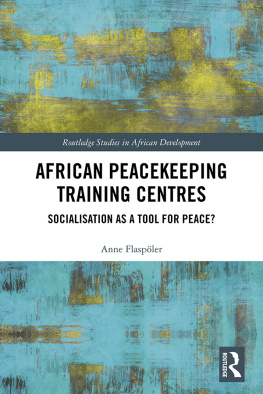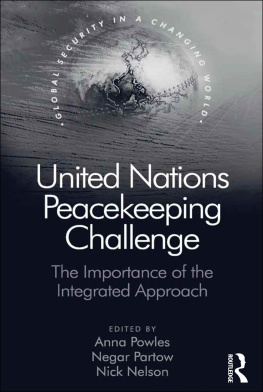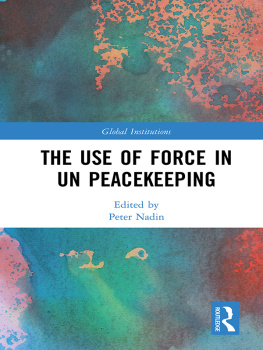Abbreviations and Acronyms
AFISMA | African-Led International Support Mission to Mali |
AU | African Union |
CAR | Central African Republic |
CNRDRE | National Committee for Recovering Democracy and Restoring the State (Comit national pour le redressement de la dmocratie et la restauration de ltat) |
CPA | Comprehensive Peace Agreement |
DPKO | UN Department of Peacekeeping Operations |
DRC | Democratic Republic of the Congo |
ECOMOG | Economic Community of West African States Monitoring Group |
ECOWAS | Economic Community of West African States |
FIB | Force Intervention Brigade |
G5 | Group of Five |
GDP | gross domestic product |
HIPPO | UN High-Level Independent Panel on Peace Operations |
MINUSCA | United Nations Multidimensional Integrated Stabilization Mission in the Central African Republic |
MINUSMA | United Nations Multidimensional Integrated Stabilization Mission in Mali |
MNF | Multinational Force |
MNLA | Movement for the National Liberation of Azawad |
MONUC | United Nations Organization Mission in the Democratic Republic of the Congo |
MONUSCO | United Nations Organization Stabilization Mission in the Democratic Republic of the Congo |
OAS | Organization of American States |
ONUMOZ | United Nations Operation in Mozambique |
P5 | permanent five members of the United Nations Security Council |
ROC | receiver operating characteristic |
SADC | Southern African Development Community |
UN | United Nations |
UNAMID | United NationsAfrican Union Mission in Darfur |
UNAMIR | United Nations Assistance Mission for Rwanda |
UNAMSIL | United Nations Mission in Sierra Leone |
UNISFA | United Nations Interim Security Force for Abyei |
UNITAF | United Task Force |
UNMIH | United Nations Mission in Haiti |
UNMIL | United Nations Mission in Liberia |
UNMIS | United Nations Mission in Sudan |
UNMISS | United Nations Mission in South Sudan |
UNOSOM | United Nations Operation in Somalia |
US | United States |
ZINB | zero-inflated negative binomial |
Acknowledgments
I would like to thank Vincent Arel-Bundock, Christian Davenport, Trevor Johnston, Lisa Koch, Shaun McGirr, James Morrow, Paul Poast, Allan Stam, Sonja Starr, Jessica Steinberg, Jana von Stein, Matthew Wells, and Alton Worthington for feedback on the earliest versions of the ideas contained in this book. I would like to thank Joseph Rakowski for discussions surrounding how best to appeal to readers outside the academy, and Gary Uzonyi Sr. for his willingness to challenge all the ideas I put forward throughout the writing process. I would like to thank Donald Jacobs for his guidance throughout the book-publishing process. Finally, I would like to thank Jacob Kathman for providing updated data on contributions to UN peacekeeping missions, which allowed for the analyses throughout this book.
About the Author
Gary Uzonyi earned his PhD in political science from the University of Michigan (2013). His research interests focus on political violence and the international community response to it. He is currently an assistant professor at the University of Tennessee, Knoxville.
Introduction: Three Dilemmas for UN Peacekeeping Missions
AT THE BEGINNING of 1991, President Siad Barres regime collapsed, heightening a humanitarian emergency throughout Somalia, in which over half the countrys population faced severe malnutrition and over one million Somalis became refugees. A year and a half later, the United Nations Security Council authorized an operation in Somalia (UNOSOM) to help monitor a cease-fire between the primary warring parties and to help provide humanitarian relief to the Somali civilian population. Despite this mission, the situation in Somalia continued to deteriorate and the humanitarian situation worsened. By December 1992, the Security Council used its Chapter VII powers to authorize a Unified Task Force (UNITAF) to use all necessary means to establish as soon as possible a secure environment for humanitarian relief operations in Somalia (Security Council 1992). Deploying about 37,000 troops in southern and central Somalia, UNITAF only had limited success in providing a secure environment. In March 2003, the Security Council sent UNOSOM II to the country with an enlarged mandate to help bring peace and stability to Somalia. However, the forces of UNOSOM II also failed to bring peace and withdrew two years later. The UN presence in Somalia did little to offer humanitarian relief, and the civil war continues to this day (UN 2018b).
Three months before Barres regime collapsed in Somalia, Rwanda experienced its own civil war when the Rwandan Patriotic Front invaded the country from its bases in Uganda. Fighting was intense, but the belligerent parties were able to establish a peace agreement by August 1993. As UNOSOM II struggled to provide security just 1,000 miles away in Mogadishu, the Security Council authorized a new mission in Rwanda (UNAMIR) to assist with the peace process. During this time, tensions in Rwanda remained high. Two days after the Security Council authorized an extension of the UNAMIR mandate in April 1994, the Rwandan government began a genocidal campaign in which nearly one million victims were murdered within three months. Within days from the start of the killing, Belgium withdrew its peacekeepers and the Security Council reduced UNAMIRs presence in the country down to under 20 percent of its initial size. Two months later, the Security Council used its Chapter VII powers to reincrease the size of UNAMIR and authorize the peacekeepers to use force, alongside Frances Operation Turquoise, in helping to establish humanitarian protection zones. However, the killings did not stop until the Rwandan Patriotic Front was able to defeat the gnocidaires and establish control of the country (UN 2018a).
In the midst of these two conflicts, the Yugoslav Wars began in March 1991. Fighting was particularly severe in the Bosnian phase of the conflict (April 1992December 1995), in which Bosnian, Croat, and Serb forces competed for control of territory. Serb militias were especially violent, frequently engaging in ethnic cleansing, murder, rape, and torture, despite the presence of the United Nations Protection Force, which had Chapter VII authorization to use all means necessary to facilitate humanitarian assistance in Bosnia. By April 1993, it was clear that the Protection Force was having difficulty providing protection to the at-risk population. The Security Council decided to declare several places in Bosnia as safe areas and ordered fighters to vacate these towns and regions. The Security Council also called for additional troops to protect these areas. Srebrenica was one of the safe areas. Yet Serbs in the region around Srebrenica refused to demilitarize and leave. Despite the presence of UN forces in Srebrenica, Serb forces captured the city in July. They soon deported the Bosniak women and girls and executed the men and boys (UN 2018c). Overall, nearly 35,000 civilians died in the Bosnian conflict.


